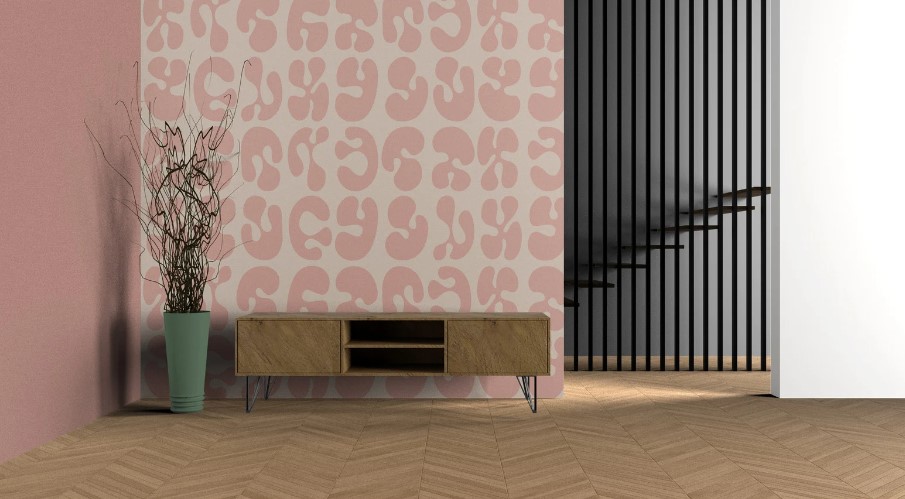
by Kanimozhi BV | Oct 8, 2024 | Wall, Interior
Woodchip wallpaper, popular decades ago, is now often viewed as outdated, and its removal can be tricky due to its textured nature.
The embedded woodchips in the wallpaper make it harder for moisture to penetrate, resulting in a more challenging removal process.
If you’re ready to tackle this home improvement project, you’re in the right place. In this guide, I’ll show you how to remove woodchip wallpaper effectively, helping you prepare your walls for a fresh, modern finish.
Why Is Woodchip Wallpaper So Difficult to Remove?
Woodchip wallpaper removal can be more time-consuming compared to other types of wallpaper as well as for the wallpaper measurement. Here’s why:
- Textured surface: The woodchips embedded in the paper make it thicker and less porous.
- Multiple layers: Often, woodchip wallpaper has been painted over several times, further sealing it to the wall.
- Adhesive: Strong adhesives used in older wallpapers can harden over time, making removal harder.
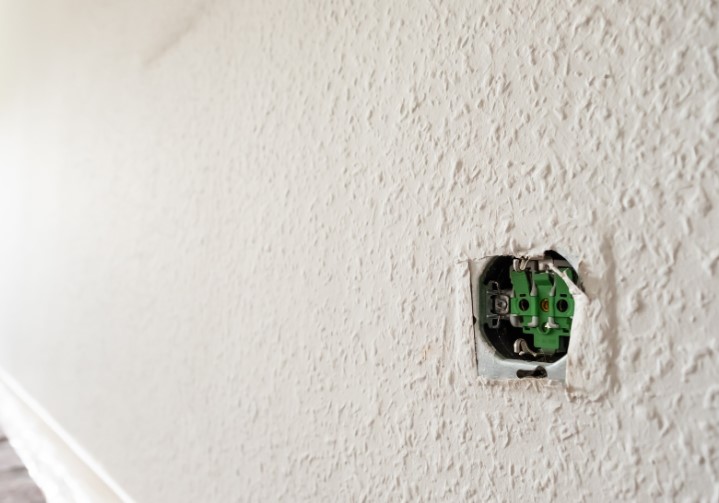
Before you start, make sure you’ve gathered the right tools. The process will be smoother and less frustrating with the correct equipment.
- Wallpaper steamer: This is the most effective way to soften the wallpaper and its glue.
- Scraper or putty knife: It helps to peel the wallpaper without damaging the plaster beneath especially for the wallpaper around windows.
- Sponge and water: For soaking areas that are too delicate for the steamer.
- Protective gloves: Prevents burns from the steam and protects your hands while scraping.
- Chemical wallpaper remover: Ideal for tough spots where steam alone isn’t working.
- Sanding tool: Useful for smoothing the wall after removal.
- Filler: For patching any holes or uneven areas after the wallpaper is removed.
How to Prepare The Room for Wallpaper Removal?
Preparation is key to making the wallpaper removal process easier and less messy.
Protecting Floors and Furniture:
- Cover the floor with plastic sheeting or an old cloth to catch debris.
- Move the furniture away from the walls to give yourself room to work.
- If furniture can’t be moved, cover it with plastic or fabric to protect it from dust and water.
Testing a Small Area:
Before diving in, it’s a good idea to test a small section of the wallpaper. Here’s how:
- Choose a small, less visible spot (like behind a door).
- Soak the area with warm water or steam to see how easily the wallpaper comes off.
- If it lifts without too much effort, you’re ready to proceed. If not, you might need to use a chemical wallpaper remover.
How to Remove Woodchip Wallpaper? – Step-by-Step Guide
Removing woodchip wallpaper requires patience and the right technique. Look over the following steps for better results:
Step 1: Soften the Wallpaper
- Start by using a wallpaper steamer. Run the steamer over a small section of the wall for about 30 seconds to a minute, allowing the steam to loosen the glue.
- Also in addition to this, you can use hot water to soak the wallpaper. Fill a spray bottle with warm water, spray the surface, and wait for the moisture to penetrate the paper.
Key tip: Avoid rushing – let the steam or water fully soak in before attempting to scrape the paper.
Step 2: Scrape Off the Wallpaper
Once the wallpaper is soft, use a scraper to begin peeling it off. Here’s how to do it:
- Hold the scraper at a slight angle and gently push it under the edge of the wallpaper.
- Use slow, steady motions to avoid damaging the wall underneath.
- Start to work in small sections, beginning from the top & moving down.
Be careful: If the wallpaper doesn’t come off easily, apply more steam or use water from hot water tank before scraping further.
Step 3: Removing Stubborn Sections
Some areas of the wallpaper may be more difficult to remove. For these spots:
- Reapply steam to soften the paper further.
- If the wallpaper still won’t budge, consider using a chemical remover. Apply it to the stubborn area, following the instructions on the product, and let it sit for the recommended time.
- After the chemical has softened the glue, resume scraping.
What Should I Do After Removing the Wallpaper?
Once the wallpaper is off, there are a few more steps to ensure your walls are ready for painting or re-wallpapering.
Cleaning the Wall Surface:
- Remove adhesive residue: Use a sponge soaked in warm, soapy water to scrub away any leftover glue or wallpaper paste. Ensure the walls are clean as well as smooth.
- Check for imperfections: After cleaning, run your hand over the wall to feel for any bumps or rough patches.
Preparation for Wall Painting or New Wallpaper:
- Sanding: If the wall feels uneven, use a sanding tool to smooth out the surface.
- Fill in holes or cracks: Apply a filler to any gaps or damage that was hidden under the wallpaper.
- Prime the wall: If you plan to paint, use a primer to create a smooth, even surface. This will help the paint adhere properly and give you a professional-looking finish.
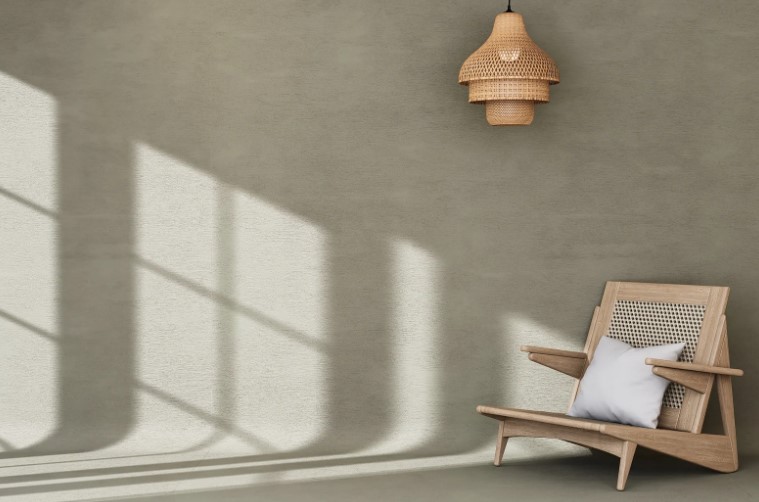
Table: DIY Wallpaper Removal vs. Hiring a Professional
| Aspect |
DIY Wallpaper Removal |
Hiring a Professional |
| Cost |
Low |
High |
| Time Commitment |
High |
Low |
| Effort |
Significant |
Minimal |
| Results Control |
Full control over the process |
Relies on the professional |
Conclusion
Removing woodchip wallpaper can feel like a daunting task, especially if you’ve never done it before. But with the right tools, some patience, and following these step-by-step instructions, you’ll be able to remove the wallpaper effectively and prep your walls for a new look.
Whether you’re planning to paint or apply new wallpaper, the satisfaction of seeing smooth, clean walls is worth the effort. Take it one section at a time, and soon enough, you’ll have a fresh canvas to work with.
FAQs on Woodchip Wallpaper Removal
1. Can I Paint Over Woodchip Wallpaper?
Yes, but it’s not recommended. The texture will still show through the paint, so for a smooth finish, it’s better to remove the wallpaper.
2. How Long Does It Take to Remove Woodchip Wallpaper?
It depends on the room size and wallpaper condition, but for an average room, expect the process to take a few hours to a day.
3. Is It Better to Hire a Professional for Wallpaper Removal?
If you have time and patience, DIY is cost-effective. Hiring a professional saves time and ensures a quicker, hassle-free process, though it’s more expensive.
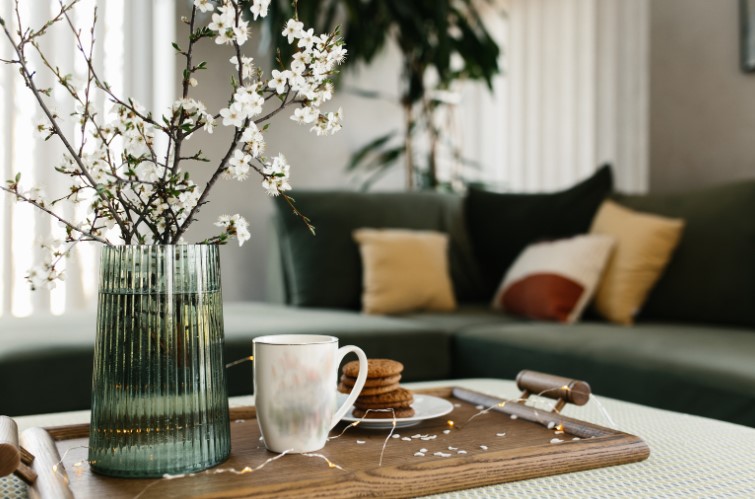
by Kanimozhi BV | Oct 7, 2024 | Wall, DIY Ideas, Interior
Are you looking for how to dispose of wallpaper paste? Wallpaper paste is a necessary part of many DIY home decor projects, but disposing of it safely and responsibly is just as important as applying it.
Whether you have a little or a lot left after finishing your wallpapering project, proper disposal can help protect both your home and the environment. The correct disposal is as necessary as choosing the wallpaper for your home.
In this guide, I’ll walk you through the best ways to dispose of wallpaper paste and answer common questions about handling leftover paste.
Why Is Proper Disposal of Wallpaper Paste Important?
Proper disposal of wallpaper paste is crucial for a few key reasons:
- Environmental Protection: Wallpaper paste, especially those containing chemicals, can be harmful to the environment if improperly disposed of. Dumping it down drains can lead to water pollution or contamination of soil and groundwater.
- Preventing Health Hazards: Chemical-based pastes contain biocides and fungicides, which are added to prevent mold growth. These substances can pose health risks if they leak into the ecosystem.
- Following Local Guidelines: Most municipalities have rules for disposing of hazardous waste, and improper disposal can result in fines or penalties. Ensuring that you follow these guidelines helps protect your local community and environment.
What Are the Types of Wallpaper Paste?
Understanding the type of wallpaper paste you’re using is essential for knowing how to dispose of it correctly. Here are the two main types:
Traditional Paste (Containing Chemicals)
- Composition: This type of wallpaper paste typically contains harmful chemicals like biocides and fungicides to prevent mold.
- Disposal Method: Must be handled as hazardous waste due to the potential environmental harm it can cause.
Non-Toxic or Eco-Friendly Paste
- Composition: Made with biodegradable or plant-based ingredients, these pastes are free from harsh chemicals.
- Disposal Method: Safer to dispose of, but still needs to be dried out before placing in the general waste.

Step-by-Step Guide: How to Dispose of Wallpaper Paste Safely
Here’s a simple, step-by-step guide on how to safely dispose of your wallpaper paste:
1. Check the Product Label for Disposal Instructions
- Importance: The first and most important step is to refer to the product label for specific instructions on disposal.
- What to Look For: Many brands offer clear disposal guidance based on whether the paste contains hazardous chemicals or is biodegradable.
2. Let the Paste Dry Out Before Disposal
- Why It’s Important: Liquid wallpaper paste should never be poured down the sink, as it can clog pipes or contaminate water systems.
- How to Do It:
- Spread leftover paste on a disposable sheet or tray and allow it to dry.
- Once dried, it becomes safe for general waste disposal (for non-toxic pastes).
3. Disposing of Leftover Paste in Small Quantities
- Method:
- Wrap dried paste in biodegradable paper or place it in a sealed bag before discarding it with your regular household waste.
- If the paste is chemical-based, consult your local waste management center for special disposal instructions.
4. Large Quantities: Take to a Local Waste Disposal Site
- Hazardous Waste: For large amounts of leftover paste, especially those containing chemicals, it’s best to take them to a local hazardous waste facility.
- Steps to Take:
- Transport the paste in a sealed container.
- Call ahead to check if the facility accepts wallpaper paste and follow their guidelines.
How Can I Use Leftover Wallpaper Paste?
Try to take accurate measurements for wallpaper to avoid additional waste. If you have leftover wallpaper paste, consider some creative or practical ways to use it as follows:
1. Store for Future Projects
- Storage Tips:
- If you expect to do more wallpapering in the near future, store the paste in an airtight container.
- Most pastes, when stored properly, can last for several months.
2. Use for DIY Crafts
- Craft Ideas:
- Wallpaper paste can be used for various DIY craft projects like paper mache or sealing paper art.
- It’s a great adhesive for homemade decor, especially when working with paper, lightweight materials or even to hang paintings.
3. Reuse for Small Repairs
- Touch-Ups: If a section of your wallpaper starts to peel or you need to reattach a small piece, leftover paste can come in handy for minor touch-ups.
Is Wallpaper Paste Harmful?
The potential danger of wallpaper paste largely depends on its composition:
1. Chemical Composition of Traditional Paste
- Harmful Ingredients: Traditional wallpaper pastes often contain fungicides, biocides, and other chemicals that prevent mold but can be harmful to both humans and the environment.
- Health Hazards:
- Skin and Eye Irritation: Coming into direct contact with wallpaper paste can lead to skin irritation or allergic reactions.
- Inhalation: If inhaled, paste fumes can cause respiratory issues.
- Environmental Impact: Improper disposal can lead to contamination of water systems, making it harmful to aquatic life and plants.
2. Safer, Non-Toxic Alternatives
- Non-Toxic Paste: Today, many wallpaper pastes are non-toxic and eco-friendly, made from plant-based materials.
- These alternatives are much safer for home use, particularly if you have pets or children.
Can You Recycle Wallpaper Paste?
While wallpaper paste itself is not usually recyclable in the traditional sense, there are some ways to minimize waste:
1. Recycling Non-Toxic Paste
- Reuse in Projects: If your paste is non-toxic and stored properly, you can reuse it for other projects, like small touch-ups or DIY crafts.
2. Composting
- Biodegradable Paste: Some eco-friendly pastes made from organic materials may be compostable. Check the product label to see if it’s safe to add to your compost bin.
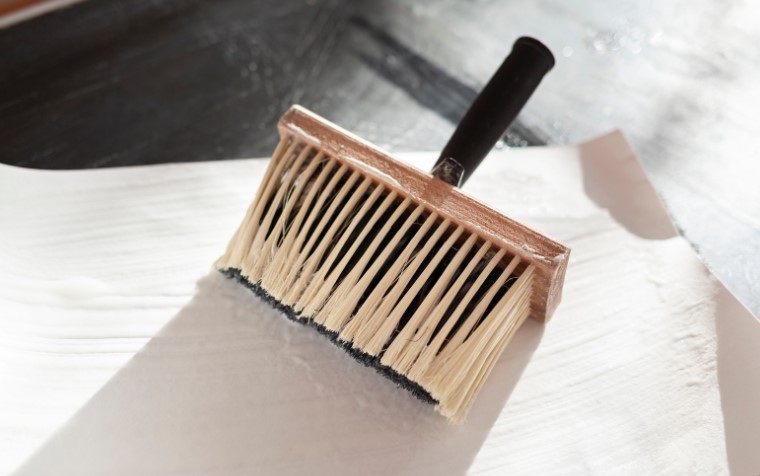
How to Clean Up Wallpaper Paste After Use?
Cleaning up wallpaper paste is an important part of the disposal process.
- What You’ll Need: Warm water, mild soap, & a scrubbing brush.
- Steps:
- Rinse tools (brushes, rollers, trays) immediately after use with warm water.
- For tough residue, soak the tools for a few hours in water mixed with mild soap, then scrub off the remaining paste.
2. Disposing of Paste-Soaked Rags and Cloths
- Disposal Method:
- If rags are soaked in a chemical-based paste, dry them out and dispose of them with your hazardous waste.
- For non-toxic paste, allow rags to dry, then dispose of them in your household trash.
Can Wallpaper Paste Be Composted?
While not all wallpaper paste can be composted, some non-toxic, biodegradable pastes can be:
Compostable Ingredients
- What to Check: If your paste is made from organic or plant-based materials, it may be safe for composting.
- How to Compost:
- Break down small amounts of leftover paste into your compost bin, but make sure it’s spread evenly to avoid clumping.
Eco-Friendly Alternatives to Traditional Wallpaper Paste
If you’re concerned about the environmental impact of traditional wallpaper paste, consider switching to eco-friendly alternatives:
1. Biodegradable or Plant-Based Pastes
- Benefits:
- Safer for the environment and your home.
- Easier to dispose of without worrying about toxic chemicals.
2. Reducing Wallpaper Paste Waste
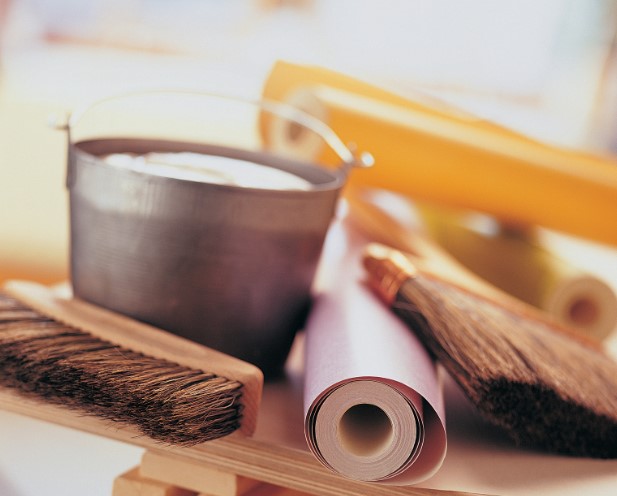
Conclusion
Disposing of wallpaper paste doesn’t have to be complicated, but it is important to follow proper procedures to protect both the environment and your health.
By understanding the type of paste you’re using, drying it out before disposal, and following local waste management guidelines, you can ensure safe disposal.
Consider eco-friendly alternatives and reuse leftover paste when possible to reduce waste and make future projects easier.
By taking these simple steps on how to dispose of wallpaper paste, you can minimize your environmental footprint and ensure a safer home.
FAQs
1. Can I Flush Wallpaper Paste Down the Toilet or Sink?
No, you should never flush wallpaper paste down the toilet or pour it into the sink. Doing so can clog your plumbing, contaminate local water systems, and harm the environment and this needs unclogging the sink or toilet.
Always dry the paste and dispose of it properly, following local waste management guidelines.
2. How Long Does Wallpaper Paste Last Once Opened?
Wallpaper paste can last for several months if stored properly in an airtight container. However, this depends on the type of paste.
Some non-toxic or eco-friendly pastes may have a shorter shelf life, so always check the manufacturer’s recommendations for specific storage times.
3. Can I Dilute Wallpaper Paste with Water for Easier Disposal?
No, diluting wallpaper paste with water and disposing of it down the drain is not recommended. It can still cause blockages in your plumbing and contribute to environmental pollution.
It’s better to let the paste dry out completely before disposing of it in the trash (if it’s non-toxic) or taking it to a waste disposal site.
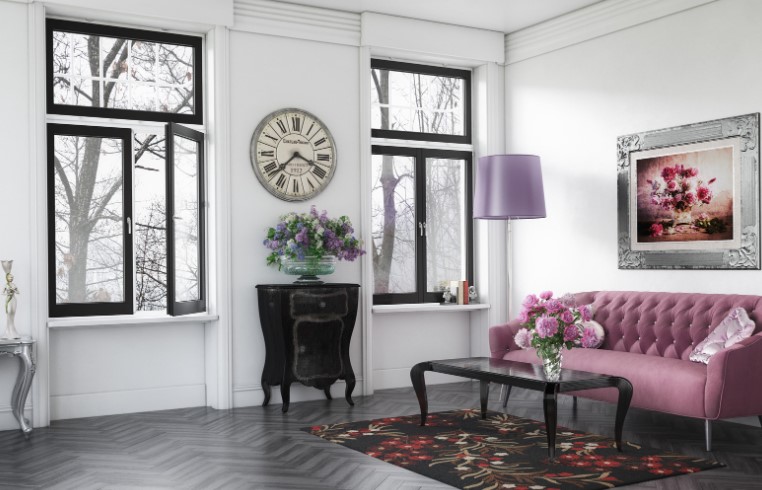
by Kanimozhi BV | Oct 7, 2024 | Wall, DIY Ideas, Interior
Are you confused and looking for how to choose wallpaper for living room? Here are the top 12 ideas. Choosing the right wallpaper for your living room can transform the entire ambiance of the space.
If you want to create a cozy atmosphere, make a bold statement, or simply freshen up the decor, wallpaper offers a unique and versatile way to personalize your home.
In this guide, I’ll walk you through 12 DIY ideas that will help you choose the perfect wallpaper for your living room. From selecting the right color scheme to installation tips, let’s dive into the world of wallpaper.
Why Is Choosing the Right Wallpaper Important for Your Living Room?
Your living room is the heart of your home, where family & friends gather, and its design plays a vital role in setting the tone for the space.
The right wallpaper acts as a backdrop that ties together lighting, decor and furniture for garden or room. It can make a room feel larger, brighter, or cozier, depending on your choice.
When choosing wallpaper, it’s essential to consider key metrics to make sure your selection is both stylish and practical:
- Room Size & Layout: Lighter tones make small rooms feel spacious, while bold patterns work best in large areas.
- Lighting: Bright wallpapers enhance darker rooms, while darker hues add depth to well-lit spaces.
- Durability: Vinyl wallpaper is durable and very easy to clean, ideal for high-traffic areas.
- Style & Aesthetic: Choose a design that complements your room’s overall theme and decor.
- Color Scheme: Ensure the wallpaper harmonizes with your furniture and flooring.
- Pattern Scale: Large patterns are better suited for expansive walls, while smaller ones fit cozy spaces.
- Installation Ease: Peel-and-stick wallpaper is ideal for DIY, while traditional pasted wallpaper may require professional help.
- Maintenance: Opt for washable wallpaper.
By keeping these factors in mind, you’ll ensure the wallpaper not only looks great but also functions well for your lifestyle.
How To Choose Wallpaper For Living Room?
What Are the Best Wallpaper Styles for Living Rooms?
When deciding on wallpaper for your living room, it’s essential to consider the various styles available. Let’s explore few top options:
Bold Wallpaper Patterns
Bold, vibrant patterns like florals or stripes can be a great way to create a feature wall in your living room. These designs add energy and personality, perfect for those who want a statement piece in their home.
- Floral Designs: Large or intricate floral patterns add a dramatic flair.
- Stripes: Vertical stripes can elongate a room, whereas horizontal ones add width.
- Statement Pieces: Use bold patterns on one wall to avoid overwhelming the room.
Geometric and Modern Designs
For a more contemporary look, geometric wallpaper designs are trending in 2024. Think clean lines, modern shapes, and neutral tones or bold color contrasts.
- Abstract Shapes: Perfect for minimalist or modern homes.
- Neutral and Bold Options: These designs can suit a variety of tastes, from understated to eye-catching.
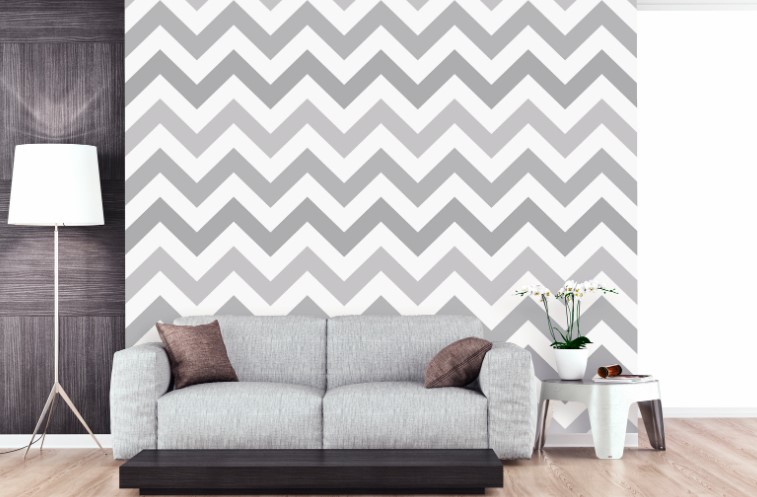
Textured Wallpaper
If you’re looking for something more tactile, consider using textured wallpaper. Designs like faux brick, linen, or metallic textures add depth and dimension to your space.
- Faux Materials: Options like faux wood or brick offer a rustic, industrial feel.
- Metallic Touches: Incorporating metallic textures adds luxury and light to a room.
How to Choose the Perfect Color Scheme for Your Living Room Wallpaper?
Choosing the right color for your wallpaper can significantly impact the mood of your living room.
Harmonizing with Furniture
One of the most critical aspects of selecting wallpaper is ensuring it complements your furniture. The color of the wallpaper should either contrast or harmonize with your furniture.
- Dark Furniture: Pairs well with light, neutral-colored wallpaper.
- Bold Furniture: Looks striking against accent wall wallpaper in softer tones.
Choosing Neutral Tones vs. Bold Colors
When deciding between neutral tones and bold colors, consider the size of your room and the amount of natural light it receives.
- Neutral Colors: Make small spaces appear larger and more open.
- Bold Colors: Create a cozy, intimate atmosphere in larger living rooms.

DIY Tips: How Do You Install Living Room Wallpaper?
Installing wallpaper can be fun and make you enjoy it. Here’s a quick guide on how to install wallpaper like a pro:
Preparing Your Walls
Before applying wallpaper, it’s essential to clean and prime your walls to ensure the wallpaper sticks well. Make sure the surface is smooth, free of dust, and dry.
- Clean the Surface: Remove any dirt, dust, or old paint to prevent bubbles.
- Prime the Walls: Use a primer to help the wallpaper adhere better.
How to Measure and Cut Wallpaper?
Wallpaper measurement includes measuring the height along with the width of your walls carefully before cutting the wallpaper. Remember to always cut slightly longer pieces to allow for adjustments.
- Measure Twice: Ensure accuracy before cutting.
- Leave Extra: Always leave an inch or two extra at the edges for trimming.
Installing Wallpaper: Step-by-Step
- Apply Paste: If needed, apply paste evenly to the back of the wallpaper or directly on the wall for peel-and-stick options.
- Start from the Top: Begin at the top of the wall and smooth out as you go, using a wallpaper brush to avoid air bubbles. You might think wallpapering around a window is crucial, but you can achieve it easily.
- Trim Excess: Cut away any extra wallpaper at the bottom or around edges using a sharp utility knife.
What Are the Current Wallpaper Trends for 2024?
Wallpaper trends in 2024 are evolving toward both sustainability and bold, maximalist choices.
Sustainability and Eco-Friendly Materials
Eco-conscious homeowners are increasingly choosing sustainable wallpapers made from recycled or natural materials.
- Recycled Materials: Wallpapers made from recycled fibers reduce waste.
- Natural Fibers: Options like grasscloth or hemp offer texture and are eco-friendly.
Maximalism with Bold Colors
Maximalism is back, with homeowners embracing bold wallpaper colors and patterns that showcase personality.
- Dramatic Colors: Bright, bold colors make a room feel unique and energetic.
- Layered Patterns: Don’t be afraid to mix patterns for a richly decorated space.
Wallpaper vs. Paint: Which One Should You Choose?
If you’re debating between wallpaper vs. paint for your wall, consider these factors:
| Feature |
Wallpaper |
Paint |
| Durability |
High, especially with vinyl options |
Moderate, needs retouching over time |
| Customization |
Unlimited patterns and textures |
Limited to colors and paint techniques |
| Ease of Application |
DIY-friendly with peel-and-stick options |
Easier, but less intricate |
| Cost |
Moderate to high, depending on material |
Lower cost, but depends on quality |
- Durability: Wallpaper, especially vinyl, lasts longer than paint.
- Customization: Wallpaper offers endless patterns and textures, while paint is more limited to customization.
- Cost: While paint is generally cheaper, wallpaper adds more customization and longevity.

Top 12 Smart DIY Wallpaper Ideas for Your Living Room
Now that you know the basics, here are 12 DIY wallpaper ideas to inspire your living room transformation:
- Feature Wall with Bold Patterns: A feature wall with a bold pattern creates a striking focal point while keeping the other walls neutral.
- Nature-Inspired Wallpaper: Bring the outdoors inside with botanical or floral designs that evoke calm and relaxation.
- Geometric Shapes: Add a modern and stylish touch with simple geometric wallpaper designs.
- Textured Wall Coverings: Consider textured wallpaper like faux brick or wood to add depth and a cozy, rustic vibe.
- Monochrome Elegance: Black-and-white patterned wallpapers offer timeless elegance.
- Vintage Floral Wallpaper: Traditional floral prints bring warmth and a touch of nostalgia.
- Stripes for Visual Height: Vertical or horizontal stripes can help manipulate the room’s visual dimensions.
- Metallic Accents: Add a bit of glamour with wallpapers that have a metallic sheen, creating a luxurious look.
- Custom Peel-and-Stick Designs: Perfect for DIY beginners, peel-and-stick wallpaper is easy to apply and remove.
- Bohemian Patterns: For a more eclectic, vibrant feel, try bold and intricate bohemian designs.
- Scandinavian Minimalism: Simple and clean designs in neutral tones create a light, airy look.
- Mural Wallpaper: Large-scale murals act as a statement piece, turning your wall into art.
Conclusion
Choosing the right wallpaper for your living room is a fun and creative process with our guide on how to choose wallpaper for living room. By considering the style, color scheme, and texture, you can transform your living room into a space that reflects your personality.
Whether you opt for a bold wallpaper pattern or a more subtle textured design, the ideas in this guide will help you make the right choice. Embrace your DIY spirit, and get ready to create a living room that truly feels like home!

by Kanimozhi BV | Oct 5, 2024 | Wall, DIY Ideas, Interior, Window
Wallpapering around a window can be tricky, but with the right approach, tools, and patience, you can achieve professional-looking results. Windows often require precise cutting, careful pasting, and seamless pattern matching to ensure a smooth finish and a beautiful look when hanging paintings on walls.
This detailed guide will help you master, how to wallpaper around a window, whether they are standard rectangular windows, bay windows, or have a deep recess.
Step-By-Step Guide On How To Wallpaper Around a Window
Before you begin, make sure you have all the tools necessary to complete the job efficiently.
- Wallpaper and paste
- Sharp wallpaper scissors or utility knife
- Tape measure and ruler
- Seam roller (optional but useful)
- Sponge and water bucket for cleaning excess paste
- Wallpaper smoother or brush
- Plumb line or laser level (to ensure wallpaper is straight)
Having these tools at hand will ensure that the process runs smoothly and avoids any delays.
Step 2: Measure and Cut the Wallpaper
Proper wallpaper measurement is the first crucial step for wallpapering around a window.
- Measure the window area: Measure the area above and below the window frame, including the depth of the recess if you have one. This makes you to decide on how many rolls of wallpaper is needed.
- Cut the wallpaper strip: Cut the wallpaper strip slightly longer than needed, leaving extra paper for trimming. Always cut it long enough to cover the window area plus a few extra inches to ensure a perfect fit. This gives you more room to adjust the paper as needed.
- Mark and cut around the window: For no-recess windows, hang the wallpaper straight across the window, making small slits in the wallpaper where the window’s corners meet. If the window has a recess, cut extra strips for this area, ensuring that they extend slightly beyond the recess for trimming later.

Step 3: Start Wallpapering
Once your wallpaper is measured and cut, it’s time to hang it.
- Hang the first strip: Begin at the top of the wall and work your way down, using a plumb line to ensure the wallpaper hangs straight.
- Press and smooth the paper: Gently press the wallpaper against the wall, smoothing out air bubbles with a brush or smoother as you go.
- Make relief cuts around the window: As you reach the window, make small diagonal cuts at the corners to allow the wallpaper to fold into the recess neatly.
Tips for smoother application:
- Always work from the top down to prevent the wallpaper from sagging.
- Use a sharp utility knife for cutting precise edges around the window frame and sill.
- Don’t forget to double-check for air bubbles by smoothing from the center out toward the edges.
Step 4: Wallpaper the Window Recess (If Applicable)
For windows with recesses, extra care is needed.
- Cut strips for the recess: Measure the depth of the window recess and cut strips to fit. Leave an extra inch or so around the edges to allow for adjustments.
- Paste and hang: Apply paste to the wall inside the recess and gently hang the wallpaper strips inside. Smooth the edges with a seam roller for a neat, crisp finish.
- Trim excess paper: Use a sharp utility knife to trim the excess wallpaper where it meets the window frame. Make sure that you press the paper into the corners before cutting for the best result.
Step 5: Finish Around the Window Frame
Now that the wallpaper is positioned around the window, you can focus on getting clean edges.
- Trim the excess: Use a straight edge or ruler to press the wallpaper into the corners of the window frame and then trim the excess with a sharp knife.
- Tuck in edges: Use a seam roller or the back of your scissors to firmly press the wallpaper along the window frame’s edges.
- Clean up: Wipe away any excess paste or blu tack in walls with a damp sponge, especially around the window frame, to ensure a clean finish.
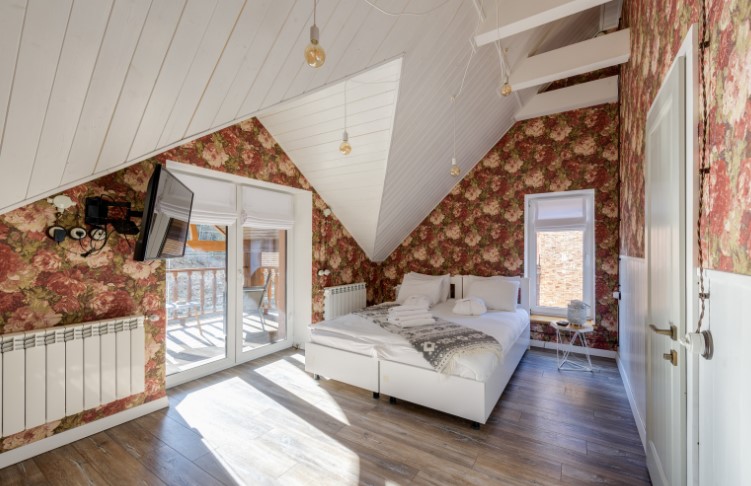
Step 6: Smooth Out the Seams
Once the wallpaper is in place, focus on the seams:
- Butt the seams together: Avoid overlapping wallpaper seams. Instead, butt them tightly together for a seamless look.
- Use a seam roller: If necessary, run a seam roller over the edges to ensure they stick well and won’t peel over time.
Step 7: Check for Air Bubbles and Final Adjustments
After hanging the wallpaper, check the entire area for air bubbles or wrinkles.
- Smooth the wallpaper: If you notice any bubbles, use a smoother or dry sponge, pressing them outwards toward the edge of the paper.
- Let the wallpaper dry: Allow the wallpaper to fully dry before making any further adjustments, especially if you plan to install curtain poles or blinds. This ensures that the wallpaper doesn’t rip or peel.
Tips for Wallpapering Different Window Types
Different windows may require slightly different approaches:
- Rectangular Windows: The most straightforward to wallpaper around, just ensure you make precise cuts around the frame.
- Bay Windows: Treat each panel of the bay window as a separate wall and be extra cautious when matching patterns at the corners.
- Sash Windows: Pay close attention to the moving parts of the window, trimming neatly around the sash without getting paste on the mechanism.
- Skylights: Secure the wallpaper firmly around skylight edges to prevent peeling over time.
- Arched Windows: Cut the wallpaper into sections to fit the curve, and use relief cuts to prevent tearing.
Conclusion
Wallpapering around windows can be a challenging task, but by following these step-by-step instructions on how to wallpaper around a window, you can achieve a polished, professional finish.
The key is careful measurement, precise cutting, and taking your time to smooth out the paper and align patterns. With patience and the right tools, even tricky window areas can look flawless.
FAQs
1. What should I do if I get air bubbles while wallpapering?
To remove air bubbles, gently smooth them out from the center of the wallpaper towards the edges using a wallpaper smoother or a dry sponge. Make sure to apply even pressure to avoid creasing the paper.
2. Can I wallpaper over a window with a radiator underneath?
Yes, you can wallpaper above a radiator. However, make sure the radiator is turned off and has cooled down before applying wallpaper to avoid drying the paste too quickly.
3. How do I wallpaper around a deep window recess?
For a deep window recess, measure the depth and cut smaller strips of wallpaper to fit the recess. Apply extra paste to ensure it adheres properly, and smooth it out with a seam roller for a crisp finish.
4. Should I overlap wallpaper at the corners?
In general, it’s better to butt wallpaper seams together to avoid visible overlaps. However, for tricky areas like corners or deep recesses, a slight overlap of about 5mm can help create a neat finish.

by Kanimozhi BV | Oct 4, 2024 | Carpet, DIY Ideas, Interior
Need tips on how to get dents out of carpet? Carpet dents from heavy furniture are an annoying but common problem.
When furniture rests in one place for too long, the carpet fibers get compressed, leading to noticeable indentations. But don’t worry, these dents aren’t permanent!
You can easily restore your carpet to its original state with a few simple tricks. In this guide, we’ll walk you through 5 smart DIY hacks that can remove dents from your carpet and prevent future damage.
What Causes Carpet Dents?
Carpet dents usually occur when heavy furniture, like sofas, beds, or bookshelves, sits in the same spot for an extended period.
The weight of the furniture compresses the carpet fibers, flattening them against the backing and making the indentations more noticeable. If left unaddressed, these dents can become more permanent as burns in the carpet, especially with high-pile carpets.
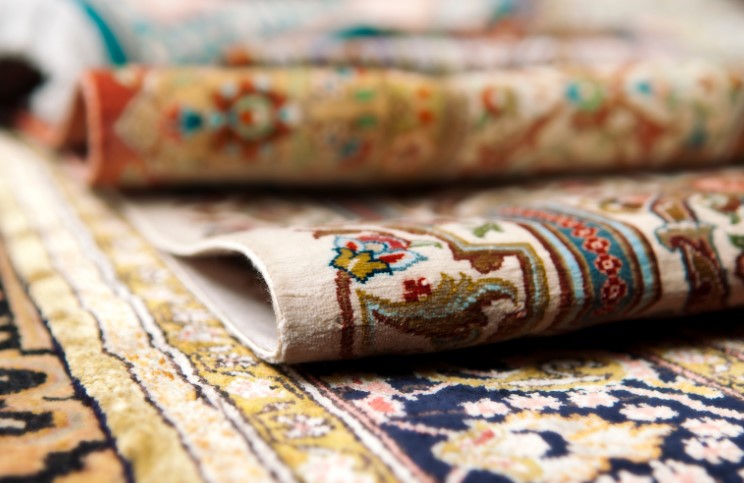
While regular vacuuming can help maintain your carpet’s fluffiness, it’s not enough to prevent dents entirely. The best strategy is a combination of DIY fixes and preventive measures, which we’ll cover below.
5 DIY Hacks on How To Get Dents Out Of Carpet – How To Remove?
How to Use Ice Cubes to Fix Carpet Dents?
One of the simplest and easiest methods to lift carpet dents is the ice cube method. This trick is particularly effective for small, shallow dents caused by furniture legs.
Materials Needed:
- Ice cubes
- A spoon or blunt tool
- A vacuum cleaner
Steps:
- Place several ice cubes directly on the dent. Use enough to cover the entire indentation.
- Let the ice melt completely over several hours (or overnight).
- Once the water has been absorbed, use a spoon or blunt tool to gently fluff the carpet fibers back into place.
- After the area dries, vacuum the spot to further lift the fibers, remove stagnant water smell and restore the texture.
This method works by rehydrating the carpet fibers, making them swell and return to their original shape. It’s safe for most carpets and doesn’t involve heat or chemicals, making it a go-to option for homeowners.
How Does Steam Ironing Work for Carpet Dent Removal?
For more stubborn dents, a steam iron can be the best powerful solution. This method uses heat and moisture to relax the carpet fibers, helping them spring back to life.
Materials Needed:
- A steam iron
- A damp cloth
- A vacuum cleaner
Steps:
- Dampen a clean cloth & place it right over the stubborn dent.
- Set your steam iron to a medium heat setting (no higher).
- Without letting the iron touch the carpet directly, gently press it over the damp cloth for about 10-15 seconds. The steam will enhance the carpet, loosening the fibers.
- Remove the cloth and use your fingers or a spoon to lift the carpet fibers.
- Finally, vacuum the area to complete the process and restore the texture.
Caution: Avoid direct contact between the iron & the carpet to prevent synthetic fibers from getting damaged. This method is best suited for synthetic carpets like nylon or polyester.

Can Vacuuming Help Remove Dents?
If you’re looking for a quick and simple solution, vacuuming can help remove minor dents, especially if they’ve just started forming.
Steps:
- Vacuum over the dented area using a brush attachment or standard vacuum head.
- Go over the spot multiple times, as vacuuming helps lift the carpet fibers by drawing them upward.
- For extra effect, fluff the fibers manually with your fingers after vacuuming.
This method works best on light dents that haven’t set deeply into the carpet. For older or larger dents, consider pairing this with one of the other methods mentioned here.
Does a Hairdryer Work for Small Dents?
A hairdryer can provide a quick fix for small dents by using heat to lift compressed carpet fibers.
Materials Needed:
- Hairdryer
- Spray bottle with water
- A comb or spoon
Steps:
- Lightly spray the dented area with water to dampen it.
- Set your hairdryer on a medium heat setting, holding it about 6 inches away from the carpet.
- As you apply heat, gently fluff the carpet fibers with a spoon or comb.
- Allow the area to dry fully before using the carpet again.
This method is effective for minor dents and is a low-risk option for delicate carpets.
How Can You Use a Plunger to Fix Carpet Dents?
A plunger may seem like an unusual tool, but it can help create suction to lift deep carpet dents, especially for larger or more persistent indentations.
Steps:
- Place the plunger over the dent & press down to create suction.
- Slowly pull up on the plunger to lift the carpet fibers.
- Repeat the process if needed, & fluff the fibers manually afterward.
This method works best on dense carpet fibers and is a quick option for pulling up compacted areas.
How to Prevent Carpet Dents in the Future?
Prevention is always better than cure. To avoid dealing with carpet dents in the future, try these effective strategies:
- Use Furniture Pads or Coasters: These distribute the weight more evenly, preventing pressure from building up in one spot.
- Move Your Furniture Regularly: Shifting the position of heavy furniture every few months can help prevent permanent indentations.
- Use Area Rugs or Carpet Protectors: Placing a rug or protector under heavy furniture can reduce the impact on the carpet.
- Install Furniture Gliders: These help furniture slide more easily, reducing the pressure that causes dents.
These small steps can save you from dealing with frustrating dents and help prolong the life of your carpet.
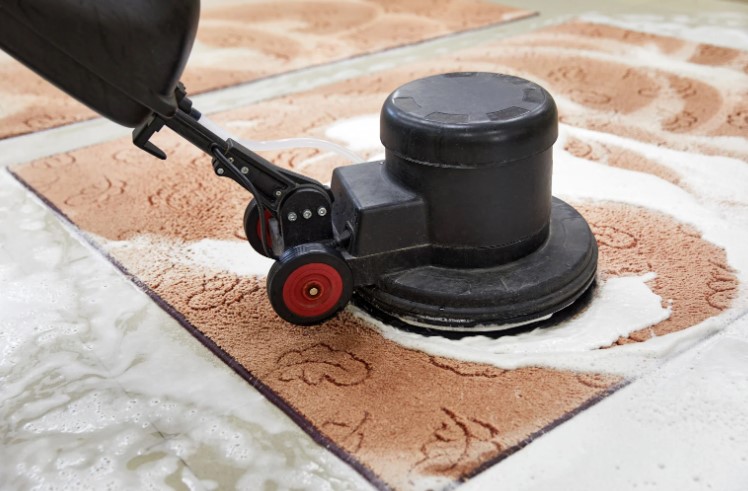
Conclusion
Removing carpet dents doesn’t have to be a daunting task. With these 5 simple DIY hacks, you can restore your carpet’s appearance and maintain its texture for years to come.
Whether you’re using the ice cube method or opting for a steam iron, these methods are practical, affordable, and effective.
By following the preventive tips on how to get dents out of carpet, you can also avoid the hassle of dealing with dents in the future. Now that you’re equipped with these solutions, say goodbye to unsightly dents and hello to a fresh-looking carpet!
FAQs:
Q1: How long does it take for ice to remove carpet dents?
It typically takes a few hours to overnight for ice to melt and fully rehydrate the carpet fibers. After the ice melts, it’s important to blot up any excess water and allow the area to dry completely.
Q2: Can you use a steam cleaner to remove dents from carpets?
Yes, a steam cleaner can be very effective for dent removal, especially for large areas. The steam helps relax the carpet fibers, allowing them to return to their natural shape.
Q3: Will carpet dents go away on their own?
Minor dents may gradually fade over time with regular vacuuming and foot traffic. However, deeper dents usually need one of the DIY methods described here to fully lift.
Q4: Can I use a clothes iron instead of a steam iron to fix carpet dents?
Yes, you can use a regular iron, but make sure to always use a damp cloth as a barrier between the iron and the carpet to prevent direct heat damage.
Q5: Are these methods safe for all carpet types?
Most methods, like the ice cube and vacuuming techniques, are safe for most carpet types. However, for delicate carpets made from natural fibers, it’s better to avoid direct heat or excessive water.

















